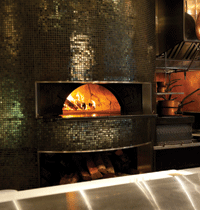Ovens continue to be a source of inspiration — and profit — for foodservice operators. Whether they’re opting for innovations such as ventless combis, expanding to more traditional open-flame cooking techniques or introducing something new to augment revenues, creative thinking is heating up the category.
New innovations
Ventless combi-ovens are the new stars, because they eliminate the need for ductwork, while offering operational flexibility.
Doug Feltmate, restaurateur and director of Foodservice & Hospitality for Genivar – WSP Group, a consulting engineering firm in Ottawa, is seeing an increasing number of ventless systems being put to good use. Permits were once a matter of debate, but the situation is changing. “We’re starting to get clarity [about] building codes and how they are being used, and a lot of manufacturers have now passed ULC testing.”
There’s been interest in a number of sectors. For example, quick-service chains are setting up additional product lines, such as the sausage program at Tim Hortons. “Stores like that don’t have the built-in ventilation needed, so ventless systems allow them to add new menu items,” Feltmate explains.
Ventless combis are also gaining attention in healthcare environments where they’re being installed in pantries on individual floors or in wards for finishing foods. Hotels use the machines for smaller banqueting needs, and they’re ideal for managing finishing needs at concession stands in locations where ventilation is not feasible.“It’s safe to say no one industry sector is running with this. They’re all using it,” Feltmate says of the ventless machines.
The most compelling selling point is the reduced cost versus built-in venting. Depending on the size and make of model, the price premium on a ventless oven can be as high as $8,000, Feltmate estimates. “But when you realize that traditional ventilation could easily cost $25,000 to $35,000, it makes [economic] sense.”
And, the team at New Brunswick Community College would agree. The decision to purchase two Rational UltraVent systems for the school came down to economics and flexibility. While the units were a $4,000 premium over standard combi-oven models — at $40,000 for two units — the benefits are significant, says Duncan Hutchison, coordinating instructor for the Culinary Program in Moncton, N.B. “Ventless was a big selling point, because we don’t have to pay for ventilation system changes,” he says. “That’s especially important since we’re changing things in a year’s time. It was a bit of a push to get through the budgetary process, but we [realized] it would be cheaper in the long run.”
Those changes may involve the relocation of several facilities, including the new demo and cafeteria kitchens. “Everything will be on wheels so we can roll the ovens between locations,” Hutchison says. “All we need is a power outlet.”
Tried and True
Scott Davidson, a Burlington, Ont.-based independent foodservice consultant, says wood-burning ovens are making a comeback. “Anything wood-burning is cool and trendy,” he says. But, wood-burning ovens can cause myriad challenges — they require wood supplies and storage as well as human skill. “You need to know how to maintain the heat, which could slow down your kitchen and your profitability,” Davidson says.
At CinCin in Vancouver, the 20-year-old wood-burning oven is the restaurant’s centrepiece. “We’re fortunate to have it, since you can’t build wood-fired ovens into restaurants anymore,” according to municipal bylaws, explains Andrew Richardson, executive chef.
Richardson came on board a year ago, and now the oven is used for more menu creations than pizza and proteins. “We put a range of products in it, including vegetables and herbs,” he explains.
The output is good, but maintenance is a challenge. The technical expertise is hard to find and repairs such as fixing cracks on the cavity wall, can take two days as the oven temperature has to reach comfortable levels so the workers can crawl inside the cavity to fix it. “When you’re open every day of the year, that’s not easy,” says the CinCin chef.
Genivar’s Feltmate reports that municipal restrictions on wood-burning appliances mean that most new installations are gas-fired ovens. “It can be quite costly to address all the [ventilation and spark-suppression] requirements. And, then there’s the wood-management thing,” he says.
Feltmate prefers to work with Wood Stone Fire Deck gas-fired ovens. “The one in my [St. Martha’s Brasserie D’Orleans] restaurant can do almost everything, from broiling steaks and salmon to flatbreads and omelettes,” he says. “It’s nice, because you have three or four natural temperature zones so you can use different placements for different foods at the same time; you can cook something quickly or slowly, warm it or finish it. You can’t do that with a thermostatic-based oven.”
CinCin’s Richardson says he loves the fact that temperatures can be so varied. “You can work with hot and cool spots to do different things at the same time. It’s a very primal way of cooking, but it’s interesting.”
Thinking outside the box
Sometimes it pays to consider something completely different. According to Davidson, a potential money maker for restaurateurs is smokers. “They make sense operationally and logistically, because they cook at such a low temperature. You can just set them up in a prep area with a bit of easy-to-pipe ventilation. And, a 20-lb. box of woodchips can easily be tucked into a corner.” His brand of choice is Southern Pride. “It’s the Cadillac of smokers and comes in a range of sizes,” says the consultant.
The math is particularly appealing, because small units can be as little as $3,000 to $4,000. “The applications for a roadhouse or mid-sized restaurant are endless, because you can bring in cheaper cuts of meat,” Davidson explains. “Why pay $17 a kilogram for prime rib when you can work with a cut of meat that costs you $5 and still get the wow factor?”
Marcus De Simone is enjoying his smoker. He opened Marky & Sparky’s Smokehouse in Toronto in the spring, and a prime piece of the 800-sq.-ft. real estate goes to the 600-lb. capacity Southern Pride SPK-500 smoker (which costs approximately $20,000), two custom ventilation hoods (which cost approximately $20,000), and two CVap cook-and-hold cabinets from Winston Industries, along with a few tables. “We went bigger than usual with our smoker,” De Simone says. “We wanted
to make sure we could meet demand.”
De Simone estimates that 80 per cent of business is takeout. Even with the extra upfront investment expense, he’s looking at a profit within the year. “The biggest cost is the meat and labour. Everything else is not that bad.”
The enthusiasm for smokers couldn’t have come at a better time for the industry, Davidson says. “The stars have lined up with this trend. With rising costs of labour and commodities, smokers can cut your protein costs by as much as seven or eight per cent. That’s huge.”





















